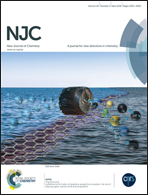Amphiphilic unsymmetrically substituted porphyrin zinc derivatives: synthesis, aggregation behavior of the self-assembled films and NO2 sensing properties†
Abstract
Two novel amphiphilic porphyrin derivatives, 5-(benzo-(4-(2-(2-hydroxy)ethoxy)ethoxy))-10,15,20-triphenylporphyrinato zinc complex [ZnT(OC2H4OC2H4OH)PP] (1) and 5-(benzo-(4-(2-(4,10-N,N-15-crown-5)ethoxy)))-10,15,20-triphenylporphyrinato zinc complex [ZnT(OC2H4NN15C5)PP] (2), were designed, synthesized, and characterized by a range of spectroscopic methods. Their electrochemistry was studied by differential pulse voltammetry (DPV). Highly ordered films of 1 and 2 were fabricated by a solution-based quasi-Langmuir–Shäfer (QLS) technique, and were characterized by electronic absorption spectroscopy, IR spectroscopy, X-ray diffraction, atomic force microscopy (AFM) and current–voltage (I–V) measurements. Experimental results revealed that J-type aggregates are formed in the QLS film of 1 and 2. The crystallinity and general molecular order in the film of 1 were improved more effectively than in 2 due to its stronger intermolecular interactions. Furthermore, the conductivity of the QLS film of 1 was approximately 1 order of magnitude larger than that of 2. This indicates a significant effect of peripheral groups on the conducting behavior of porphyrins. In addition, the gas sensing behavior of the QLS films of 1 and 2 toward the electron acceptor gas, NO2, was investigated at concentrations 200 and 800 ppm, respectively. The sensitivity, stability, and reproducibility follow the order 1 > 2, revealing the effect of intermolecular interaction, film structure/morphology, and low-lying LUMO energy level on sensing performance. Unexpectedly, a decreased current response towards NO2 for the QLS films of both 1 and 2 was obtained for the first time, which unambiguously demonstrated the n-type semiconducting nature of 1 and 2. The present result represents not only the first example of n-type metalloporphyrin-based thin solid films obtained by a solution-based method, but more importantly provides an efficient way to enhance the performance of n-channel organic semiconductors through the combination of molecular design and the film fabrication technique.


 Please wait while we load your content...
Please wait while we load your content...